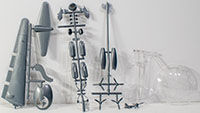
Atlantis Model Company 1/184 B-36 Peacemaker Kit First Look
By Michael Benolkin
| Date of Review | April 2020 | Manufacturer | Atlantis Model Company |
|---|---|---|---|
| Subject | B-36 Peacemaker | Scale | 1/184 |
| Kit Number | H205 | Primary Media | Styrene |
| Pros | Welcome return of a classic subject | Cons | See text |
| Skill Level | Basic | MSRP (USD) | $21.95 |
First Look
 |
 |
 |
Before the entry of the United States into World War II, military planners knew that the US would soon be drawn into the conflict and also realized that there would be no easy way to conduct strategic bombing should Great Britain fall to Germany. Development of a long-range intercontinental bomber was started that would eventually lead to the B-36, though in the early 1940s, the technology wasn't ready for such a huge set of requirements, so intermediate steps were put forth. The company that would undertake this monumental task was Consolidated Aircraft. Consolidated was the result of a merger between Gaulladet Aircraft and the famous Dayton-Wright Companies. In 1943, Consolidated merged with Vultee to become Convair.
The first prototype B-36 flew in mid-1946 and was the largest aircraft ever flown and powered by six R4360 Wasp Major engines rated at roughly 3000 horsepower apiece. Later versions were rated at 3800 horsepower. Designed as a conventional strategic bomber, the B-36 could carry 86,000 pounds of bombs (the B-52 can carry roughly 70,000 pounds of bombs). The early prototypes struggled with the best way to move the aircraft on the ground without collapsing the existing runway/taxiway structures. The XB-36 had single-wheel main landing gears, but the tires were enormous. Experiments were undertaken with tracked landing gear to improve the ground footprint of the huge bomber, but ultimately a four-wheel main gear was adopted to provide the ideal footprint and a measure of safety should one of the tires go flat during take-off or landing.
Production B-36s entered service with the new Strategic Air Command, a branch of the new USAF charged with strategic bombing and delivery of nuclear weapons anywhere on the globe should the US be attacked. The B-36 would be the mainstay of the Strategic Aiir Command until two Boeing bombers, the B-47 and B-52 would come online and maintain the deterrence of aggression. The two Boeings had the ability to fly non-stop anywhere in the world at higher airspeeds with the help of air refuelling, both capabilities beyond the reach of the behemoth B-36. The B-36 was phased out of the USAF by 1959.
While the B-36 continued its service, incremental improvements were made to the aircraft with more powerful R4360 engines, plus the addition of four J47 turbojet engines outboard of the six piston engines. In addition to its bombing mission, the B-36 was also an ideal platform for long range reconnaissance missions as the RB-36. The concept of providing integral fighter escort and quick-penetration damage assessment came in the form of a special trapeze mounted into the bomb bay of an experimental GRB-36 to carry the F-84. While experiments were conducted with straight-wing Thunderjets, it was the RF-84K that was designed as the parasite-capable reconnaissance fighter that would deploy from under the B-36.
Jimmy Stewart is well-known for his movies and timeless characters, but he was also an experienced combat commander who was in line for his own bomb wing before the end of World War II. After the war, Stewart returned to Hollywood, but he retained his commission in the US Air Force. When he took the role of 'Dutch' Holland, a former World War II bomber pilot reactivated into the new Strategic Air Command, Stewart delivered one of the best insights into the early cold war operations of the still-new United States Air Force. The movie is one of the few remaining resources to see and hear the B-36 (and the B-47) in operation. Every time I watch the film, of course I get the urge to build one of Monogram's scale masterpieces, their 1/72 scale B-36 Peacemaker!
Here's another gem discovered by Atlantis Models when they acquired a library of stored kit molds acquired after Hobbico's (Revell) bankruptcy. This is Revell's vintage B-36 Peacemaker produced in box scale (1/184 in this case) and first released in the mid-1950s. Unlike some of the kits they've brought back to life, this kit was reissued a number of times through the mid-1980s before ending up on the shelf.
This release is molded in silver styrene and presented on eight parts trees. Among the features and options in this kit:
- Basic construction
- Model is designed with landing gear up and includes a display stand
The decals provide markings for one example carrying a notional tail number 452057 (the only 2057 was a B-36B-10-CF 44-92057).
This is another classic 'box-scale' kit perched somewhere between the 1/144 scale standard and 1/200 used by companies like Hasegawa. Even at 1/184 scale, this is not a small model though it will be easier to park than the larger scale models like Monograms 1/72 kit. With the help of some good paint skills and some decals out of your spares box, you can replicate any number of aircraft that served over a decade on the front lines of the cold war before they were retired. As mentioned above, one good reference is Jimmy Stewart's Strategic Air Command movie.
If you want a fun weekend (or so) project or an inexpensive model for a young modeler, look no further than this classic kit now back on store shelves!







